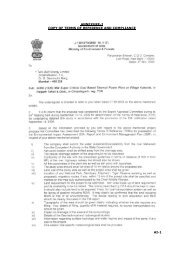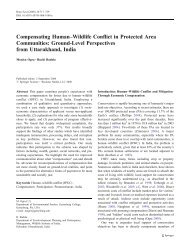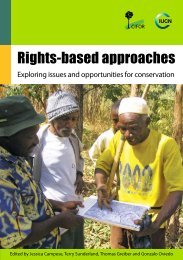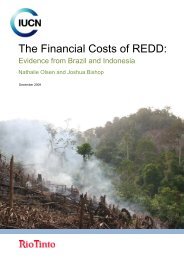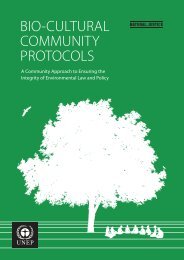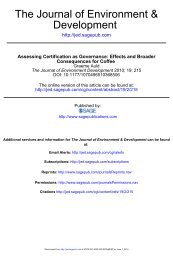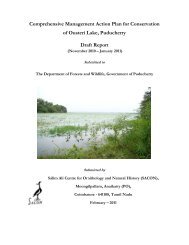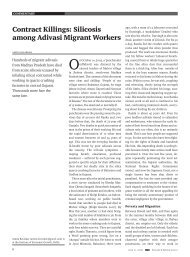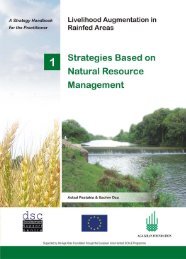biodiversity assessment in some selected hill forests of south orissa
biodiversity assessment in some selected hill forests of south orissa
biodiversity assessment in some selected hill forests of south orissa
Create successful ePaper yourself
Turn your PDF publications into a flip-book with our unique Google optimized e-Paper software.
INTRODUCTION: Biodiversity refers to the variety and variability <strong>of</strong> all life <strong>in</strong>clud<strong>in</strong>g all species <strong>of</strong><br />
plants, animals and micro-organisms, the ecosystems and the ecological processes <strong>of</strong> which they are parts.<br />
Where rich <strong>biodiversity</strong> is an <strong>in</strong>dicator <strong>of</strong> a healthy ecosystem, it also provides wide range <strong>of</strong> goods and<br />
services that are essential for the sustenance <strong>of</strong> the biota. Conservation and susta<strong>in</strong>able use <strong>of</strong> <strong>biodiversity</strong> is<br />
an <strong>in</strong>dicator <strong>of</strong> susta<strong>in</strong>able development. Unfortunately, dur<strong>in</strong>g the last century, a drastic decl<strong>in</strong>e <strong>in</strong><br />
<strong>biodiversity</strong> has been observed <strong>in</strong> different parts <strong>of</strong> the world <strong>in</strong> an alarm<strong>in</strong>g rate lead<strong>in</strong>g to mass ext<strong>in</strong>ction.<br />
Anthropogenic activities and over exploitation <strong>of</strong> the resources exist<strong>in</strong>g <strong>in</strong> an ecosystem has destroyed its<br />
homeostasis and altered the habitat <strong>of</strong> the native species. This has threatened the survival <strong>of</strong> endemic<br />
species mak<strong>in</strong>g them endangered. Therefore, the present day ecosystem research has advocated the<br />
conservation <strong>of</strong> habitat and the environment for giv<strong>in</strong>g all the species to grow undisturbed <strong>in</strong> their native<br />
habitat. Despite the considerable worldwide efforts to establish the wildlife protected areas, destruction <strong>of</strong><br />
wildlife habitats has rema<strong>in</strong>ed the lead<strong>in</strong>g threat to <strong>biodiversity</strong>. This destruction, tak<strong>in</strong>g different forms (i.e.<br />
degradation, fragmentation or outright loss) prompted ma<strong>in</strong>ly by such factors as poverty, demographic<br />
factors, land tenure systems, <strong>in</strong>adequate conservation status, development policies and economic<br />
<strong>in</strong>centives. Anthropogenic activities such as overgraz<strong>in</strong>g, deforestation, bush fires, shift<strong>in</strong>g cultivation,<br />
developmental activities like m<strong>in</strong><strong>in</strong>g, urbanization and road construction <strong>in</strong>side the protected areas are found<br />
to be the major causes <strong>of</strong> lose <strong>in</strong> <strong>biodiversity</strong>. Last but not the least climate change is emerg<strong>in</strong>g as a new<br />
threat to the whole ecosystem. The Eastern Ghats are isolated <strong>hill</strong> ranges <strong>in</strong> Pen<strong>in</strong>sular India (Andhra<br />
Pradesh, Orissa, Tamil Nadu and Karnataka), harbors primarily tropical moist deciduous vegetation, which<br />
represents species <strong>of</strong> high economic, timber, medic<strong>in</strong>al potential, lies <strong>in</strong> 110 30' to 210 0' N Latitudes and<br />
770 22' to 850 20' E Longitudes. Eastern Ghats are highly significant <strong>in</strong> terms <strong>of</strong> its Bio-diversity. Of the<br />
estimated 3,200 flower<strong>in</strong>g plant taxa, about 100 are endemics that need immediate attention for their<br />
conservation (Jonathan, 2006). There are 528 tree taxa under 271 genera belong<strong>in</strong>g to 80 families<br />
(Sandhyarani et al., 2007) distributed <strong>in</strong> different regions <strong>of</strong> Eastern Ghats In total 454 species under 243<br />
genera and 78 families are endemic to Eastern Ghats (Kanyana, 2008). Out <strong>of</strong> the 7,500 species plants <strong>of</strong><br />
medic<strong>in</strong>al value reported <strong>in</strong> India, about 1800 species are known to occur <strong>in</strong> Eastern Ghats. It is the abode <strong>of</strong><br />
62 tribes who susta<strong>in</strong> their livelihood from the forest resources <strong>of</strong> Eastern Ghats. At least 50 dye yield<strong>in</strong>g<br />
plants and 40 aromatic plants are also known to occur <strong>in</strong> this region. The Eastern Ghats constitute the<br />
pr<strong>in</strong>cipal mounta<strong>in</strong> system <strong>of</strong> Orissa extend<strong>in</strong>g over 1.5 Lakh sq. km. areas, which is just 4.25% <strong>of</strong> the total<br />
landmass <strong>of</strong> the state, extend<strong>in</strong>g from north <strong>of</strong> Similipal <strong>in</strong> Mayurbhanj district and runs through Malkangiri<br />
bas<strong>in</strong>g on geological and tectonic considerations. Eighteen districts <strong>of</strong> Orissa <strong>in</strong>clud<strong>in</strong>g 14 protected areas<br />
(13 wild life sanctuaries, one Biosphere reserve, one National Park, two tiger reserve and one Ramser<br />
Wetland) comes under the Eastern Ghats <strong>of</strong> India. The <strong>biodiversity</strong> <strong>of</strong> Orissa consists <strong>of</strong> 2760 species <strong>of</strong><br />
angiosperms, 543 species <strong>of</strong> algae, 132 species <strong>of</strong> pteridophytes, 473 species <strong>of</strong> birds, 110 specie <strong>of</strong>



